

546. $950
Atkins Clock Manufacturing Co. “Parlor No. 1”, 1855-1859. This is the company that succeeded
Atkins, Whiting & Co. and was eventually forbidden from using the Ives wagon spring mechanism; as a result, they switched to fusee
movements as found here. This is a 30-day, double-wind round movement with solid steel gears that seem unusual, but I can’t
find a reference to steel gears in Gregory and King’s book “The Clocks of Irenus Atkins”; there is a picture of a prototype movement
with solid gears on page 103. There are few examples of this model with fusee movements in the Antique Clocks Price Guide; the
most recent sale was at Schmitt’s in 2010 for $1150. The clock stands 17.5 inches tall and 13 inches wide in a nice rosewood
veneer all around, with angled corners in front. There is a dry split to the lower left side panel and the upper left side panel
is a stained replacement, well disguised. The upper glass is original, with an intact gold leaf design backed by tan/grey paint;
the lower mirror is typical and certainly old if not original. The painted metal dial is likely original and the hands are correct
to style. The door handles should be ivory; these are small metal knobs. There is a partial label inside, enough to determine
the manufacturer. The clock is running and keeping time. $1000-$1200.
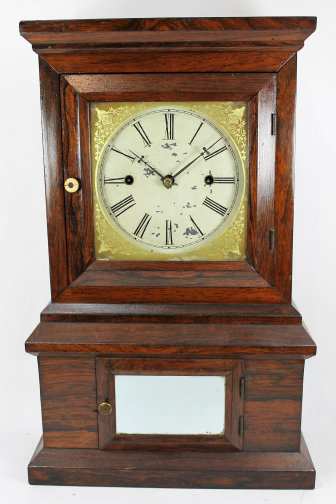
547. $1500
Atkins Clock Manufacturing Co. “Parlor No. 2”, 1855-1859. I can find only one sale for this
model in the Antique Clocks Price Guide, from 2004, so it is extremely uncommon, as noted on page 46 of Gregory and King’s book on
Atkins clocks. This model uses Ives’ Type III wagon spring lever mechanism to provide 30 days of power to this time-only round
movement. Note the presence of two solid steel gears on the right side. The rosewood-veneered case is 18.5 inches tall
with good veneer all around. The dial glass is original, with good gold filigree and tan backing, while the lower mirror is
old but probably not original. The original painted dial is flaking but not yet unacceptably; the hands are not quite a perfect
match, with the minute hand likely being a replacement. The upper door retains its ivory door handle. There are some nice
labels on the back, one of which describes previous ownership. A Parlor No. 2 sold in January of this year on eBay for around
$2975 (Buy it now/Best offer). $2000-$3000.
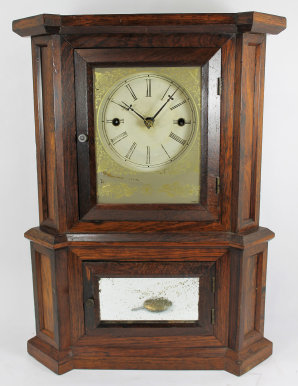
548. $325
Austrian portico repeater, ca. 1880. This wood portico clock stands 22 inches high and 13 inches
wide with a mixture of light wood and either black trim or ebony wood in places. The top shows wear from repeated cleaning,
but from the front the wear isn’t evident. There are four fluted columns with brass trim pieces, a wood top piece in gold leaf,
and a lyre backpiece behind a fancy pendulum. The dial is porcelain with a repair next to the left winding arbor, behind an
old flat glass in a brass bezel. The clock is a repeater, first sounding the quarter-hour (one, two, three, or four strikes
on a wire gong) followed by the hour count on a different wire gong. It is running robustly and striking correctly, but the
hour strike spring is not winding fully and will need to be looked at. The dial says “Franz Schaffler in Wien”. $350-$500.
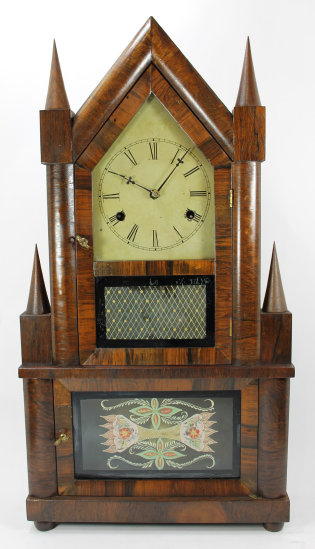
549. $725
J. Birge double steeple, ca. 1848. John Birge was a cabinet maker and so was usually in partnership
with others; this is a rare example of a clock with a movement rather crudely stamped “Birge & __(?) | USA”, presumably Birge
& Co., the company he formed after his partner Thomas Fuller died in 1848. There is not enough of the label left to confirm
the company, but “John” is evident on the manufacturer line. By 1849 he’d partnered with Ambrose Peck. Birge had rescued
Joseph Ives from debtor’s prison in NY and had rights to use Ives’ patents, including the 30-hour wagon spring movement found here. The movement is dirty and we couldn’t get it running, but a cleaning should be all that is needed. The rosewood veneer is quite
nice all around; I think the cone finials are replacements. The painted dial is old, the hands correct to style but the minute
hand is a replacement. All three glasses are likely mid-20th century as are the reverse-painted designs. The case is 24
inches tall on bun feet. $750-$1000.
Interior Glasses Left view Right view
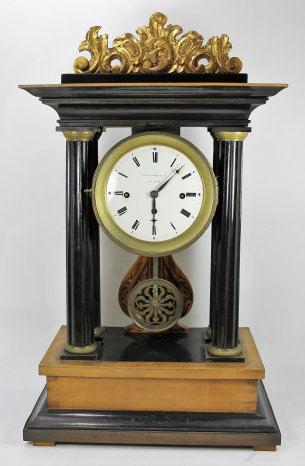
550. $275
F. Kroeber “Bunkerhill”, ca. 1880. The 21.5-inch case is ebony with gold incising; the colored
leaves and berries are artistic license by a previous owner. I suppose you could paint over them in black lacquer if you don’t
find the artwork attractive. The case is in excellent condition otherwise, and this is a difficult clock to find. The
old glass retains all of the gold stencil, the dial is porcelain, and there are fancy hands that look like Kroeber hands. The
8-day signed movement is running and striking the hours on a nickel bell; there is a fancy Kroeber adjustable Jacot’s regulator pendulum
(note that the pointer hand is missing the pointer portion). There is a black beat scale on the backwall and two very nice labels
on the back. A Bunkerhill sold on eBay this year for $536 and it lacked the decorated glass. There are no sales in the
Antique Clocks Price Guide. $275-$500.

551. $10
European? Carriage clock, ca. 1880? This clock is 9 inches tall with the handle up. It is black-lacquered metal on top and bottom, brass-plated columns and bezel, very worn, and a nickel or tin repousse front, all
in need of serious cleaning. There are two side glasses, one with a frosted pattern, the other broken, and glass over the paper
dial. It’s a backwind hairspring movement with an alarm that sets on the back. It is not signed anywhere and will only
run for a few seconds. $10-$50.
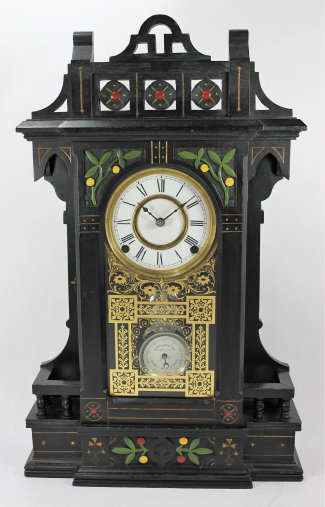
552. $75
Terry Clock Co. “Escort Pearl”, ca. 1885. The Terry Clock Co. was founded by Silas Burnham Terry
(son of Eli Terry) in 1867 and dissolved in 1888. This model was not listed in their 1875 catalog so it was likely made after
SB Terry’s death in 1876. It’s 8 inches high with the handle up, in black enamel with gilt and pearl trim. The lower right
mother-of-pearl trim piece is missing and there is considerable wear to the paint around the signed paper dial. There are two
side glasses. It holds a one-day lever movement with an alarm that is running. Note that the minute hand is shortened;
the alarm bell is on the bottom. One setting knob is missing and the other is a replacement that does not fit well. $100-$200.
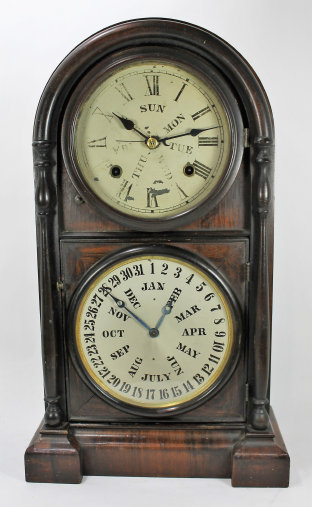
553. $325
Welch, Spring & Co. “Italian No. 3”, ca. 1873. Welch, Spring & Co. absorbed the B.B.
Lewis Clock Co. around 1870 and began manufacturing complex calendar clocks using Lewis’ calendar movements. In this example
they also used a calendar label made by the Lewis company (note the Bristol, rather than Forestville address). For more detail
see Ly’s book on “Calendar Clocks”, page 349. This clock holds an E.N. Welch-stamped 8-day time-and-strike movement. We
have not succeeded in keeping it running but oiling the rear pivots might help. The upper dial is faded and has some chipping,
the hands are replacements. The lower dial is in better shape; both are painted, probably the original paint; both glasses are
original. The rosewood veneer on the 20-inch case is in good shape all-around. There are two good labels inside. We sold one in January for $495. $400-$600.
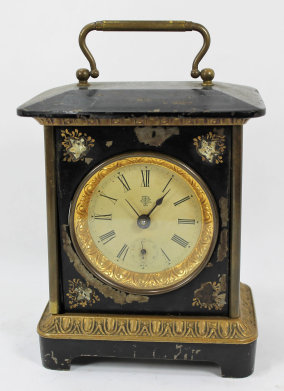
554. $275
Welch, Spring & Co. “Italian No. 3”, ca. 1873. Like #553, this is an early calendar from
Welch, Spring & Co., based on the calendar door label. The 8-day time-and-strike movement is signed E. N. Welch, Forestville
CT and is running, striking, and the day and date calendar hands are advancing. Both dials are papered, the hands are
replacements, the glasses are original. The 19.5-inch case is rosewood veneered but the base is an old replacement in walnut,
stained to match. There are remains of a label inside, enough to determine the maker. $275-$400.
Left view Right view Interior Door Back

555. $60
Seth Thomas “Banjo No. 5”, 1929. This 30-inch mahogany-cased banjo contains the Seth Thomas
8-day, time-only pendulum movement #123A. The dial is silvered, with some marring near the “8”; the hands are correct, behind
a flat glass. The throat and door glass applied images are as shown in the catalog photo (Ly, Seth Thomas Clocks and Movements,
Vol. 1, page 79). It is running and keeping time. $75-$120.
